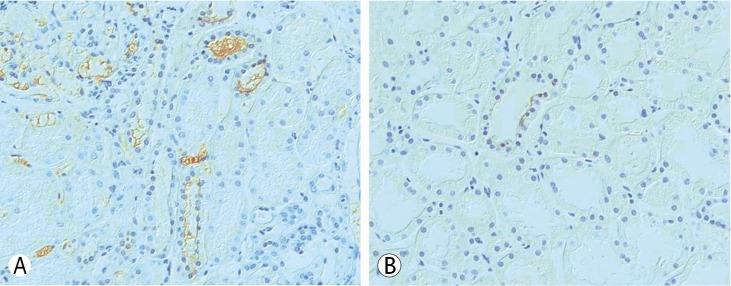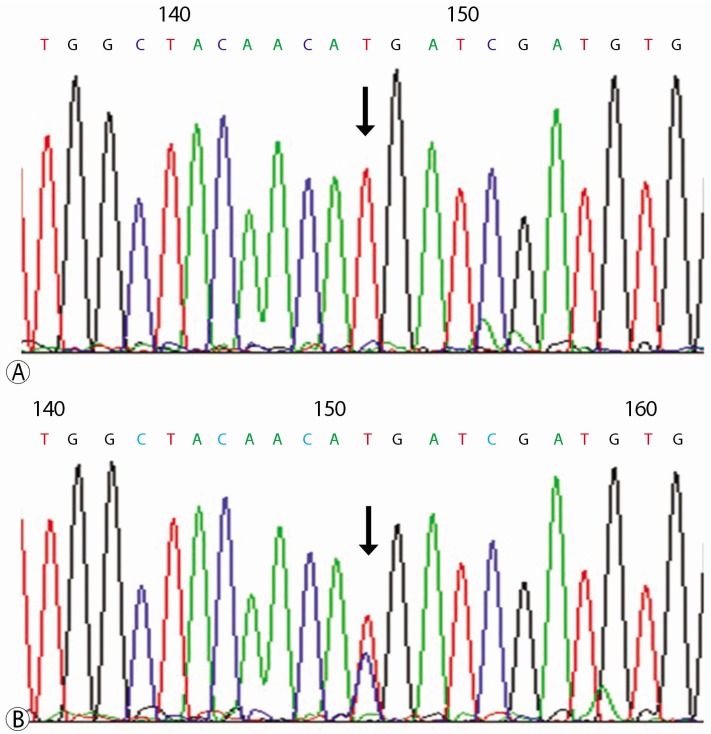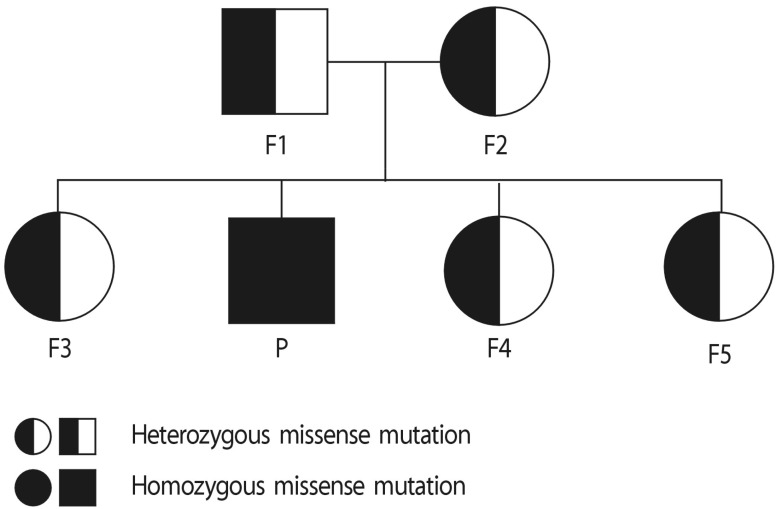Electrolyte Blood Press.
2016 Jun;14(1):16-19. 10.5049/EBP.2016.14.1.16.
A Pedigree with c.179 Cytosine to Threonine Missense Mutation of SLC12A3 Gene Presenting Gitelman's Syndrome
- Affiliations
-
- 1Department of Internal Medicine, Keimyung University School of Medicine, Daegu, Korea. hansy@dsmc.or.kr
- 2Department of Anatomy, Keimyung University School of Medicine, Daegu, Korea.
- 3Institute for Medical Genetics, Keimyung University School of Medicine, Daegu, Korea.
- 4Keimyung University Kidney Institute, Daegu, Korea.
- KMID: 2328426
- DOI: http://doi.org/10.5049/EBP.2016.14.1.16
Abstract
- A 42-year-old man came to the hospital presenting chest discomfort and general weakness. He had come to the hospital with the same symptoms 3 months ago and 12 years prior. His laboratory test showed hypokalemia, hypomagnesemia and hypocalciuria. The arterial blood gas analysis showed hypochloremic metabolic alkalosis. He had an ultrasonography guided renal biopsy, the result was normal at light microscopy and immunofluorescence microscopy. However, a special stain for Na-Cl cotransporter was weakly expressed compared with the control. The patient and his family underwent genetic sequencing about the SLC12A3 gene. He had a homozygous mutation in the 179th nucleotide of Exon 1 on the SLC12A3 gene (p.Thr60Met) and his parents and sisters were diagnosed as carrier state of Gitelman's syndrome (GS). GS is an inherited tubular disorder which presents mild hypokalemia, hypomagnesemia and hypocalciuria. Since the symptoms and laboratory results are not severe, it can go unnoticed by physicians. Herein we present a family with GS, diagnosed by genetic sequencing.
Keyword
MeSH Terms
Figure
Reference
-
1. Melander O, Orho-Melander M, Bengtsson K, et al. Genetic variants of thiazide-sensitive NaCl-cotransporter in Gitelman's syndrome and primary hypertension. Hypertension. 2000; 36:389–394. PMID: 10988270.
Article2. Simon DB, Nelson-Williams C, Bia MJ, et al. Gitelman's variant of Bartter's syndrome, inherited hypokalaemic alkalosis, is caused by mutations in the thiazide-sensitive Na-Cl cotransporter. Nat Genet. 1996; 12:24–30. PMID: 8528245.3. Luo J, Yang X, Liang J, Li W. A pedigree analysis of two homozygous mutant Gitelman syndrome cases. Endocr J. 2015; 62:29–36. PMID: 25273610.
Article5. Gitelman HJ, Graham JB, Welt LG. A new familial disorder characterized by hypokalemia and hypomagnesemia. Trans Assoc Am Physicians. 1966; 79:221–235. PMID: 5929460.6. Li C, Zhou X, Han W, et al. Identification of two novel mutations in SLC12A3 gene in two Chinese pedigrees with Gitelman syndrome and review of literature. Clin Endocrinol (Oxf). 2015; 83:985–993. PMID: 25990047.7. Maki N, Komatsuda A, Wakui H, et al. Four novel mutations in the thiazide-sensitive Na-Cl co-transporter gene in Japanese patients with Gitelman's syndrome. Nephrol Dial Transplant. 2004; 19:1761–1766. PMID: 15069170.
Article8. Shao L, Lang Y, Wang Y, et al. High-frequency variant p.T60M in NaCl cotransporter and blood pressure variability in Han Chinese. Am J Nephrol. 2012; 35:515–519. PMID: 22627394.
Article9. Lee JW, Lee J, Heo NJ, Cheong HI, Han JS. Mutations in SLC12A3 and CLCNKB and Their Correlation with Clinical Phenotype in Patients with Gitelman and Gitelman-like Syndrome. J Korean Med Sci. 2016; 31:47–54. PMID: 26770037.
Article10. Gamba G. Molecular physiology and pathophysiology of electroneutral cation-chloride cotransporters. Physiol Rev. 2005; 85:423–493. PMID: 15788703.
Article11. Reissinger A, Ludwig M, Utsch B, et al. Novel NCCT gene mutations as a cause of Gitelman's syndrome and a systematic review of mutant and polymorphic NCCT alleles. Kidney Blood Press Res. 2002; 25:354–362. PMID: 12590198.12. Shao L, Ren H, Wang W, et al. Novel SLC12A3 mutations in Chinese patients with Gitelman's syndrome. Nephron Physiol. 2008; 108:29–36.





